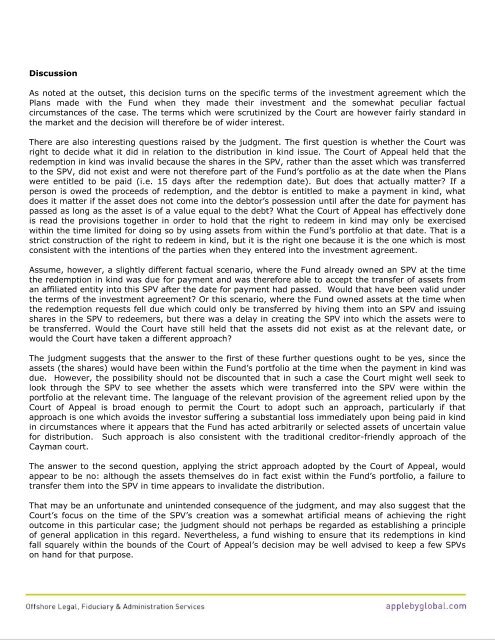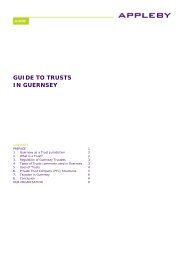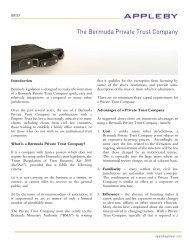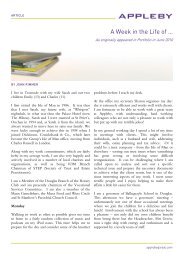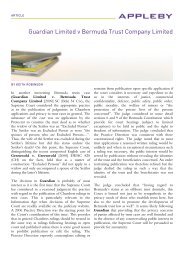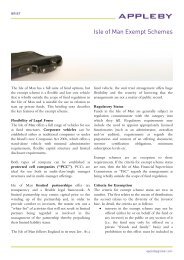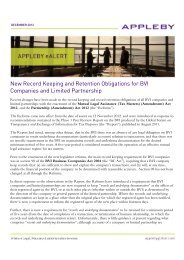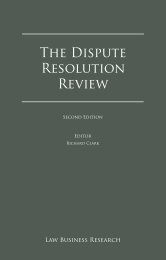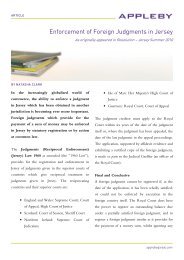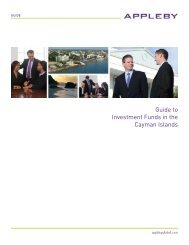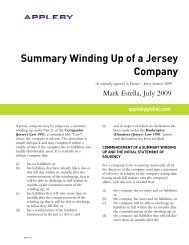FIA Leveraged Fund: The Cayman Court Takes a Strict ... - Appleby
FIA Leveraged Fund: The Cayman Court Takes a Strict ... - Appleby
FIA Leveraged Fund: The Cayman Court Takes a Strict ... - Appleby
Create successful ePaper yourself
Turn your PDF publications into a flip-book with our unique Google optimized e-Paper software.
DiscussionAs noted at the outset, this decision turns on the specific terms of the investment agreement which thePlans made with the <strong>Fund</strong> when they made their investment and the somewhat peculiar factualcircumstances of the case. <strong>The</strong> terms which were scrutinized by the <strong>Court</strong> are however fairly standard inthe market and the decision will therefore be of wider interest.<strong>The</strong>re are also interesting questions raised by the judgment. <strong>The</strong> first question is whether the <strong>Court</strong> wasright to decide what it did in relation to the distribution in kind issue. <strong>The</strong> <strong>Court</strong> of Appeal held that theredemption in kind was invalid because the shares in the SPV, rather than the asset which was transferredto the SPV, did not exist and were not therefore part of the <strong>Fund</strong>’s portfolio as at the date when the Planswere entitled to be paid (i.e. 15 days after the redemption date). But does that actually matter? If aperson is owed the proceeds of redemption, and the debtor is entitled to make a payment in kind, whatdoes it matter if the asset does not come into the debtor’s possession until after the date for payment haspassed as long as the asset is of a value equal to the debt? What the <strong>Court</strong> of Appeal has effectively doneis read the provisions together in order to hold that the right to redeem in kind may only be exercisedwithin the time limited for doing so by using assets from within the <strong>Fund</strong>’s portfolio at that date. That is astrict construction of the right to redeem in kind, but it is the right one because it is the one which is mostconsistent with the intentions of the parties when they entered into the investment agreement.Assume, however, a slightly different factual scenario, where the <strong>Fund</strong> already owned an SPV at the timethe redemption in kind was due for payment and was therefore able to accept the transfer of assets froman affiliated entity into this SPV after the date for payment had passed. Would that have been valid underthe terms of the investment agreement? Or this scenario, where the <strong>Fund</strong> owned assets at the time whenthe redemption requests fell due which could only be transferred by hiving them into an SPV and issuingshares in the SPV to redeemers, but there was a delay in creating the SPV into which the assets were tobe transferred. Would the <strong>Court</strong> have still held that the assets did not exist as at the relevant date, orwould the <strong>Court</strong> have taken a different approach?<strong>The</strong> judgment suggests that the answer to the first of these further questions ought to be yes, since theassets (the shares) would have been within the <strong>Fund</strong>’s portfolio at the time when the payment in kind wasdue. However, the possibility should not be discounted that in such a case the <strong>Court</strong> might well seek tolook through the SPV to see whether the assets which were transferred into the SPV were within theportfolio at the relevant time. <strong>The</strong> language of the relevant provision of the agreement relied upon by the<strong>Court</strong> of Appeal is broad enough to permit the <strong>Court</strong> to adopt such an approach, particularly if thatapproach is one which avoids the investor suffering a substantial loss immediately upon being paid in kindin circumstances where it appears that the <strong>Fund</strong> has acted arbitrarily or selected assets of uncertain valuefor distribution. Such approach is also consistent with the traditional creditor-friendly approach of the<strong>Cayman</strong> court.<strong>The</strong> answer to the second question, applying the strict approach adopted by the <strong>Court</strong> of Appeal, wouldappear to be no: although the assets themselves do in fact exist within the <strong>Fund</strong>’s portfolio, a failure totransfer them into the SPV in time appears to invalidate the distribution.That may be an unfortunate and unintended consequence of the judgment, and may also suggest that the<strong>Court</strong>’s focus on the time of the SPV’s creation was a somewhat artificial means of achieving the rightoutcome in this particular case; the judgment should not perhaps be regarded as establishing a principleof general application in this regard. Nevertheless, a fund wishing to ensure that its redemptions in kindfall squarely within the bounds of the <strong>Court</strong> of Appeal’s decision may be well advised to keep a few SPVson hand for that purpose.


